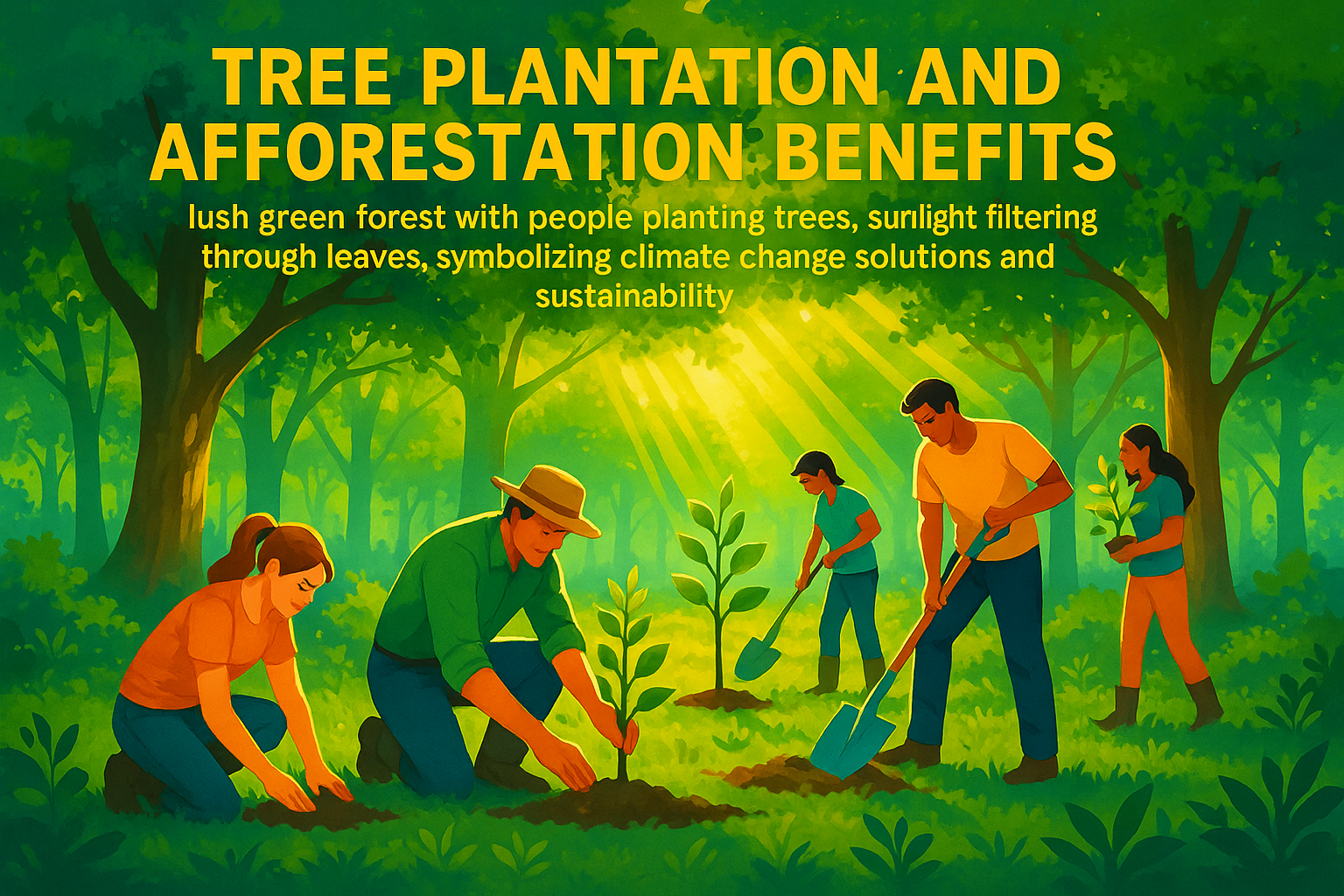As the world grapples with escalating climate change, the importance of tree plantation and afforestation has never been more critical. These natural processes play a vital role in restoring environmental health, supporting biodiversity, and mitigating the adverse effects of global warming. This blog explores the multifaceted tree plantation and afforestation benefits and highlights why acting now is crucial for a sustainable future. 🌿
🌲 Understanding Tree Plantation and Afforestation
Tree plantation involves the deliberate planting of trees in areas where there may have been no previous tree cover, while afforestation refers to establishing forests in regions that were not previously forested or were deforested. Together, these practices aim to replenish tree populations, improve ecosystems, and provide a green infrastructure that supports life on Earth. 🌎🌿
🌿 Environmental Benefits of Tree Plantation and Afforestation
One of the most profound tree plantation and afforestation benefits is their role in combating climate change. Trees naturally absorb carbon dioxide (CO₂) during photosynthesis, significantly reducing greenhouse gases in the atmosphere and helping limit global warming.
According to studies by the United Nations Environment Programme (UNEP) and World Resources Institute (WRI), afforestation projects can sequester large amounts of carbon, making them a cost-effective solution to offset industrial carbon emissions. 🌞🌏
Moreover, trees improve air quality by filtering pollutants such as sulfur dioxide, ammonia, and nitrogen oxides. They also produce oxygen through photosynthesis — essential for all living beings. Urban tree plantations help reduce the urban heat island effect, making cities cooler and more livable during heatwaves. ☀️🌳😌
🌾 Soil and Water Conservation Through Tree Plantation
Trees play a critical role in preventing soil erosion. Their roots bind the soil, reducing runoff and protecting the land from heavy rains and winds. This maintains soil fertility and prevents land degradation — essential for agriculture and food security. 🌾🌍
In terms of water conservation, forests act as natural sponges. They absorb rainfall, reduce surface runoff, and release water slowly into rivers and streams, promoting groundwater recharge. This is vital for sustaining water supplies during dry periods and reducing flood risks. 🌧️🌊
🦜 Biodiversity Enhancement and Ecological Balance
Afforestation helps restore habitats for countless species of plants, animals, and microorganisms. Forests are among the most diverse ecosystems on Earth, supporting a wide range of biodiversity. Increasing tree cover through plantation and afforestation can revive endangered species populations and maintain ecological balance. 🦋🐝🦉
By providing food, shelter, and breeding grounds, trees sustain wildlife and promote ecosystem resilience. This biodiversity is crucial for natural processes like pollination, pest control, and nutrient cycling — all of which directly or indirectly benefit humans. 🌺🌿🐞
💼 Economic and Social Tree Plantation and Afforestation Benefits
Beyond environmental gains, tree plantation and afforestation benefits extend to the economy and society. Forest-based industries create employment opportunities in nursery management, planting, logistics, and maintenance — supporting livelihoods, especially in rural regions. 👩🌾🌱🏞️
Additionally, trees contribute to public health by improving air quality and reducing heat stress. Green spaces foster relaxation and boost mental wellbeing. ☘️🌳😊
Carbon trading and credits also open new economic opportunities. Landowners and governments can generate income through carbon offset markets, incentivizing large-scale afforestation projects. 💰🌍♻️
🌏 Climate Change Mitigation and Adaptation
Tree plantation and afforestation are vital strategies for both mitigating and adapting to climate change. By lowering CO₂ levels, they slow down global warming and reduce extreme weather impacts.
Afforestation with native species maintains ecosystem stability, reducing vulnerability to pests and diseases. These forests act as long-term carbon sinks while safeguarding soil and water resources for future generations. 🌳🛡️
For more insights on climate adaptation, visit IPCC Climate Change Reports.
🤝 How Individuals and Communities Can Support Tree Plantation
Every individual can make a difference. Participating in local plantation drives, supporting environmental NGOs, and advocating for green policies are great starting points. Planting native species in gardens and public spaces ensures the growth of healthy, sustainable green cover. 🌼🌳🌻
Communities can collaborate with local authorities and NGOs to identify suitable areas for afforestation. Educational campaigns can raise awareness and encourage sustainable participation. 📚🌱🌍
For community action resources, explore WWF’s Reforestation Initiatives.
⚠️ Challenges in Tree Plantation and Afforestation Projects
While tree plantation and afforestation benefits are immense, challenges exist. Poorly planned projects can lead to monocultures that harm biodiversity or strain water resources. Selecting the right species, maintaining natural forest diversity, and monitoring growth are essential. 🌲🧐
Engaging local communities and respecting indigenous knowledge ensures ecological and cultural alignment, making projects more successful. 🤝🌿🌱
🌳 Conclusion: Act Now for a Greener Tomorrow
Tree plantation and afforestation benefits extend far beyond the simple act of planting trees — they are powerful solutions to climate change, environmental degradation, and social challenges. 🌍
The time to act is now. By embracing sustainable practices and supporting reforestation initiatives, individuals, communities, and governments can collectively secure a healthier, greener planet for future generations. 🌎✨🌳
